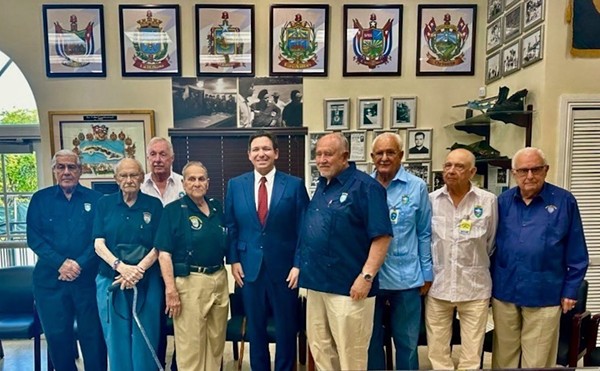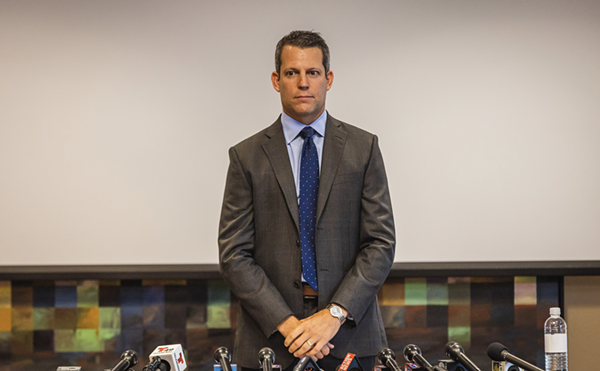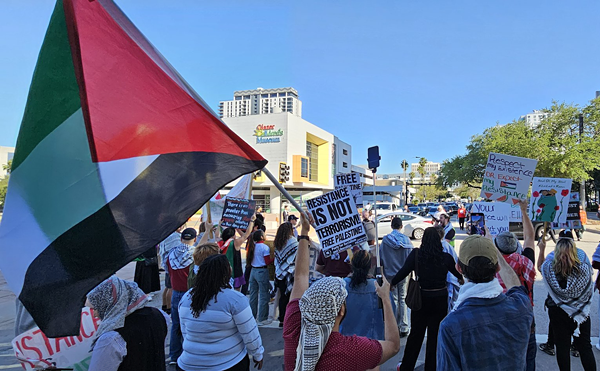Mindful of how emotions can frequently transcend logic when it comes to voting, St. Petersburg Area Chamber of Commerce CEO Chris Steinocher went straight for the heart when he addressed a room full of enthusiastic advocates for the Greenlight Pinellas initiative last Friday morning in Clearwater.
“You hear the word ‘care.’ This literally is a vote about caring for our community,” he intoned, asking those in the audience who gathered at the Pinellas Realtor Organization office to look at those people sitting next to them. “We are not alone. And what we need to do is stand strong together.”
Steinocher’s words were a symbolic red flag to a room overflowing with enthusiasm about the most concrete plan ever to improve transportation in Pinellas County. The measure that will go before voters in November calls for a hike in the county’s sales tax from 7 to 8 percent, with the extra funds going toward a 65 percent increase in bus service and a new light-rail system connecting St. Petersburg to Clearwater.
Unlike a similar plan that went down to defeat in Hillsborough County, this plan could be more appealing to homeowners in that it calls for a tax swap. Currently the Pinellas Suncoast Transit Authority (PSTA) is funded by property taxes. But the ballot measure calls for an end to that source of funding and replacing it with new income derived by increasing the sales tax in the county. That will shift the burden from homeowners to citizens and tourists who shop in Pinellas establishments.
Some critics object to the term “tax swap,” since it’s not revenue neutral. Currently, PSTA takes in $32 million annually to fund its system. Switching over to a sales tax would bring in $130 million to pay for an expanded bus system, and 24 miles of rail from downtown St. Petersburg through the Gateway/Carillon area to downtown Clearwater. “You’re getting an additional 95 million, but you are funding a significantly better bus system,” County Commissioner and PSTA chair Ken Welch said last week.
Initial polls show support for the plan overall, but nobody involved with the effort think it’s going to be an easy haul. While the political and business elite in Pinellas are strongly in support, that’s hardly a harbinger of what the populace thinks, as evidenced by the voters’ rejection of the Hillsborough proposal in 2010.
A poll sponsored by the Tampa Bay Times, Bay News 9 and AM 820 News Tampa Bay in December showed 55 percent of Pinellas voters supporting the referendum, 36 percent opposing it and 9 percent unsure. A more recent survey conducted by St. Pete Polls shows that the most fervent opposition is in the northern part of the county, with District 4 voters opposing the measure by a 63-31 percent margin.
Former St. Pete City Councilman and PSTA Chair Jeff Danner says different parts of the plan must be showcased to different parts of the community. “There’s a huge number of people who go from Pasco into Carillon, so having those BRT routes to take a few percentage of those commuters off of McMullen Booth Road and U.S. 19 is important to North County,” he says.
Pinellas County Commissioner Karen Seel agrees, citing the introduction of trolley service from Safety Harbor to Dunedin as another selling point. Don Ewing of the Council of North County Neighborhoods says his organization has done its own polling and that once people are shown the plan, they’re supportive.
Opponents of Greenlight Pinellas often refer to the David vs. Goliath aspect of this fight, as they expect to be heavily outspent in the eight and a half months before the election. But they do believe that their ace in the hole is a reluctance to raise taxes.
hough the excitement was palpable in Clearwater last week, there was a similar level of intensity last month in Largo, where approximately 120 people gathered at the Abundant Life Ministries on a Tuesday night for the first public gathering of the nascent political action committee No Tax For Tracks. The group’s roots are in the Pinellas Tea Party movement, which made its presence felt at the County Center in Clearwater in recent years for its opposition to a variety of projects, though efforts to get the commission to temporarily remove fluoride from the water supply proved to be the group’s Waterloo.
Providing inspiration that night was Debbie Dooley, the national coordinator of the Tea Party Patriots and co-founder of the Atlanta Tea Party. Her leadership in helping to thwart a 1-cent sales tax increase for a Georgia transportation effort in 2012 (while being outspent $8 million to $15,000) has became the stuff of Tea Party legend.
“We were laughed at,” she told the audience. “We were basically told, ‘Do you think that you’re going to defeat us?’” she recounted with satisfaction.
However, one thing that Dooley had working for her — a benefit not enjoyed by No Tax For Tracks — is bipartisan support. In Georgia both the NAACP and the Sierra Club worked with Tea Party activists, because those relatively progressive groups had their own objections to the plan.
But that strategy won’t unfold in Pinellas. The Sierra Club has been instrumental in organizing groups to attend PSTA meetings and show visible support for the initiative over the past year. “We’ve been the primary source of grassroots support, and we intend to do even more this year,” says the Club’s Phil Compton.
The Sierra Club campaign, Florida Healthy Air, considers the lack of clean, modern transportation options the community’s biggest economic and environmental problem.
“We work with the Chamber of Commerce, who support transit options for business reasons,” says Compton, “but we’re also motivated by the fact that our cars’ tailpipe emissions are our biggest source of carbon emissions as well as a major factor in Hillsborough having Florida’s worst smog.”
Although St. Pete NAACP head Reverend Manuel Sykes wasn’t available for comment, his organization also backs the measure.
When asked about this, Barbara Haselden, the leader of No Tax for Tracks, admitted that she hasn’t attempted to reach out to the NAACP. She says she did make an entreaty to Compton, but was rejected for reasons she’s still uncertain about. “It makes you wonder if it’s all political instead,” she wonders.
Haselden is a founding member of the South Pinellas 9/12 group, and has been a constant at County Commission and PSTA meetings over the past couple of years, part of the Tea Party-led insurgence that compelled a majority of County Commissioners to support a proposal to eliminate fluoride from the county’s water supply. But that move provoked a fierce backlash, resulting in Democrats Charlie Justice and Janet Long — two strong proponents of Greenlight Pinellas, incidentally — to defeat Republican challengers who supported fluoride removal in 2012. Now Norm Roche remains the only standard-bearer for the cause on the Board.
Another critic of the transit plan, neurosurgeon and political activist Dr. David McKalip, recently paid St. Pete Polls to survey voters about the plan and found 60 percent rejected it after they learned that it would increase the sales tax by a penny. However, his questions never mentioned that the tax would provide for a 65 percent increase in overall bus service in Pinellas, and calls for added bus rapid transit lanes (BRT), increased frequency and extended hours. But McKalip objects when told that his poll was skewed.
“The advocates, when they ask questions, they never say the train is only from St. Petersburg to Clearwater, that’s misleading,” he says. “They talk about using public funds in the polls, but they don’t talk about a sales tax hike. They talk about using a 1-penny increase in the hike when it’s really $130 million. The entire modus operandi of Greenlight Pinellas is to deceive the voters. That’s the only way that they can come close to winning.”
Regarding his claim that advocates are boasting that the train will ultimately provide service from Pinellas to Hillsborough, McKalip is referring to the official draft map of the plan, which shows dotted black lines crossing Pinellas to the Marion Transfer station in Tampa.
A connection across the bay by rail is definitely not in the current plan, but could be a future step. In October, Florida Department of Transportation Secretary Ananth Prasad said the state is committed to building an estimated $25 million substructure to accommodate light rail on the replacement span of the Howard Frankland bridge.
Barbara Haselden from No Tax for Tracks says that the government should only do what is needed, not what it wants to do, citing a U.S. Census report that says that only 1.6 percent of the public in Pinellas relied on public transportation in 2010, with the average commute 23 minutes. “Other cities may have a need they’re trying to resolve, but we really don’t have a problem.”
Meanwhile, as Pinellas becomes fully engaged on advancing transportation choices for the future, transit advocates in Hillsborough County say they’re tired of biding their time.
Three and a half years after their penny-cent transit tax went down to defeat, the Hillsborough County leadership policy group is making noises about putting up its own sales tax measure, perhaps in just a little over a year.
“Otherwise we’re waiting until November of 2016, and that’s just to take action,” says Hillsborough County Commission chair Mark Sharpe. “That’s six years after it lost in 2010, and if someone’s going to tell me with a straight face that waiting around six years makes good business sense, then they don’t know business. We can’t sit back while other regions move forward on transit,” he adds, alluding to the Pinellas campaign. Others say that such talk is absurdly early.
On a recent Thursday night around three dozen members of Connect Tampa Bay met at the Tampa Museum of Art to unveil their plan for transit in Hillsborough, the result of consulting with over 3,000 members. Their plan calls for a 1-cent sales tax increase that would raise $204 million annually, slicing those funds into one third for transit, one third for roads, nearly a quarter for buses, and a smaller slice for bike trails and even ferry service.
That latter request may come to fruition before anything else. Last week before the Board of County Commissioners, former commissioner Ed Turanchik won approval for a study to be conducted on a possible ferry service from near Apollo Beach to MacDill Air Force Base, with an ultimate goal of providing transportation from downtown Tampa to downtown St. Pete. But all eyes will be on Pinellas this year to see if Tampa Bay can finally be dragged out of the transportation backwoods.
The St. Pete Chamber’s Steinocher was a major proponent of the rejected Lens design for the St. Pete Pier last August. It was obvious from his words last week that the experience seared something into him.
“People feel like they’re entitled to their own facts and data,” he recounted about his frustrations with the Stop The Lens movement. He added that there was “mass confusion” about what the Pier was ultimately going to look like. “I really believe that uncertainty killed people on that one.”
Although he told the audience in Clearwater last week that it’s more about communicating neighbor to neighbor, he doesn’t preclude television ads as part of the marketing campaign. But whatever the method, he says people need a comfort level that a yes vote is the way to move the entire community forward.
Whether they’ll be persuadable won’t be known until November 4.
















